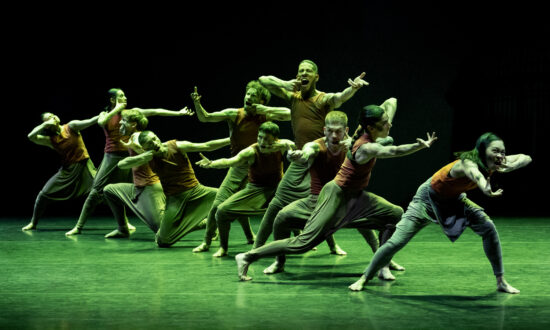Blue’s set is a white raised semi-circularish platform, seamlessly joined with a curve to a backdrop in the same white, ribbed texture – redolent of the ripples of waves.
It serves as a canvas for projections of water – eddies, swirls, rising and lowering tides. Without coloured lighting it takes on a stark, almost institutional feel.
The edges of this world are visible, in line with the play’s setting in that place between land and sea, solidity and uncertainty, fear and love.
The first clue to the theme of this structurally straightforward monologue is the nostalgic opening music – Memories of You, from the great American songbook.
Mark, played by Callan Purcell (most recently seen as Aaron Burr in Hamilton), has a letter from his mother. It lies unread until the final moments.
In a mostly unbroken first-person exposition (and there’s a lot of straight-out exposition), we learn about young Mark’s life in an unspecified place, 40 minutes’ drive from the sea.
His home with his beloved brother John of almost the same age (“Irish twins” but they “fuckin’ knew” they weren’t Irish) and his parents seem happy. The home is warm and colourful – although there are hints of an off-kilter relationship with his mother, who he describes as a writer, although not in a formal, published way.
It moves quickly – maybe too quickly – into the first cataclysmic event and then a descent into understandable mental health crises given the trauma the character describes.
The last section of the play takes another turn, which I won’t describe here, but it is centred on Mark’s relationship with his mother after he moves away from home to study and, hopefully, become a writer himself.
They stay in contact via old-fashioned letters, much to the amusement of Mark’s new girlfriend and flatmate, Effie, an interesting character who makes him throw away his “bad” books (Charles Bukowski among them).
In Purcell’s playing, Mark is an unusual, tender character – he loves footy and talks about smoking “darts”, but his inner language is often oddly formal, sometimes stiltingly so.
Purcell plays him with keen vulnerability, but we never understand enough about who he is, where he’s come from, or what his broader world looks like.
As a portrait of mental crisis, this fragmented approach might work, but there are some challenges in the writing that Purcell struggles to overcome. He rarely has the opportunity to channel other characters, but these fleeting moments are where the play comes to life, as well as in the occasional moments of wry humour.
We are also rarely allowed to “see” through Mark’s eyes, except in one memorable and moving scene as he dives into the ocean (via a hidden channel in the set).
Purcell falls into a habitual rising inflection at the end of sentences, which is difficult to listen to, particularly in the fast-paced sections when the drama intensifies.
Ultimately, the play’s problems for this reviewer are most revealed in the final section, which focuses on Mark’s relationship with his mother.
We’re told, early, that she had a habit of looking at him in a strange way – sorrow or disappointment? We never learn why and she remains a distant figure – inexplicable.
Maybe Mark himself doesn’t know who she really is, but given their constant letter writing (which surely presented a visual opportunity, left untaken), it makes the dramatic ending ring hollow.
Blue, a Belvoir St Theatre production presented at the Adelaide Festival by State Theatre, was universally praised on its debut season in Sydney.
It is written by Thomas Weatherall, a young actor known for his performances in the Heartbreak High TV series reboot, and he has described it as “a very personal fiction”. Perhaps this explains the degree of difficulty that Purcell and director Deborah Brown faced in bringing this production to the Festival stage.

Get InReview in your inbox – free each Saturday. Local arts and culture – covered.
Thanks for signing up to the InReview newsletter.
Weatherall himself played the character of Mark in its debut run, and I can only imagine that the characterisation was more cohesive and natural in the hands, body and voice of its creator. Curiously but perhaps tellingly, the publicity images – including the cover of the program – feature Weatherall, not Purcell, in the role of Mark.
The intimate play is not assisted, either, by the venue – the Scott Theatre being a traditional and relatively capacious performing space.
Theatre-goers willing to roll with Blue’s quirks will find some enlightenment in the world drawn by Weatherall. He intended this as “a kind of unprescribed therapy” and the piece wrestles and struggles its way, ultimately, into the light – even one filtered through the waves.
Blue is playing at the Scott Theatre until March 16. Note: the play contains references to suicide.
Read more 2024 Adelaide Festival coverage here.
Support local arts journalism
Your support will help us continue the important work of InReview in publishing free professional journalism that celebrates, interrogates and amplifies arts and culture in South Australia.
Donate Here




